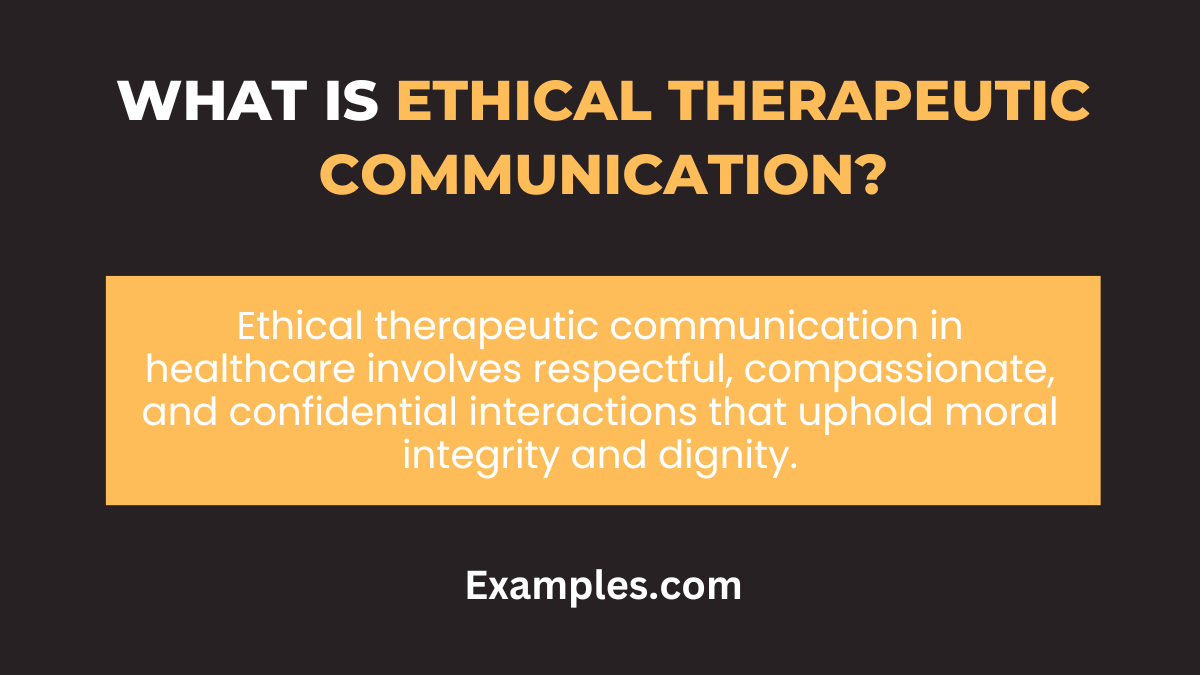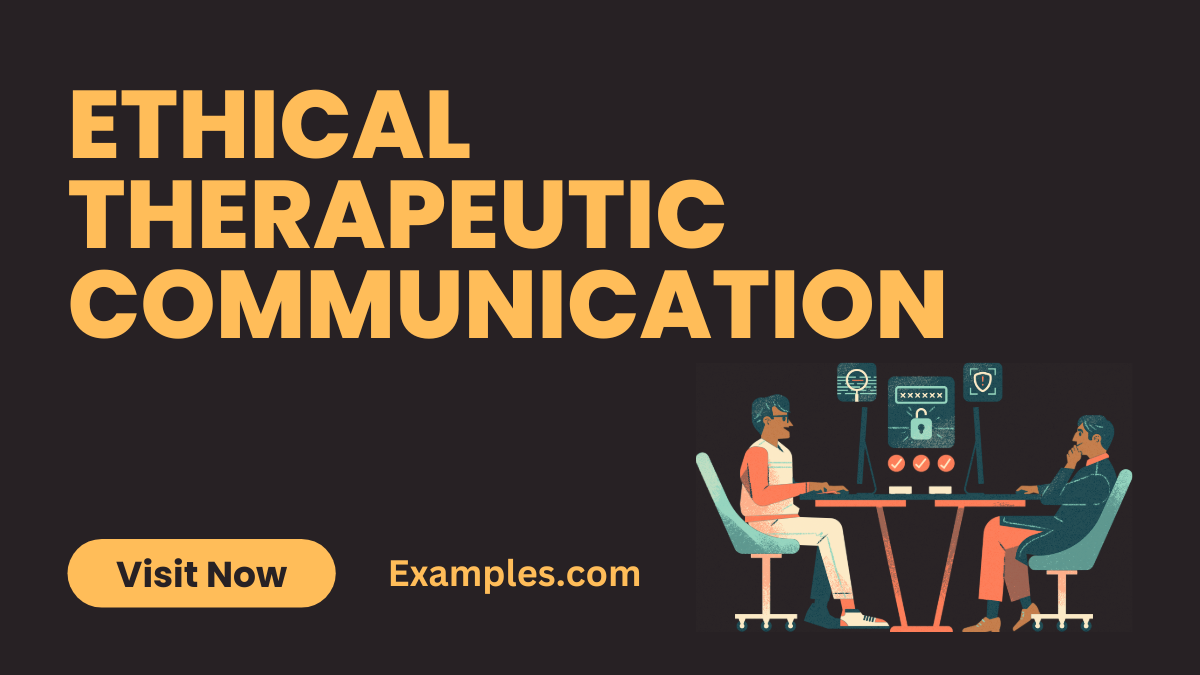Ethical Therapeutic Communication
Ethical Therapeutic Communication is an essential aspect of oral communication in healthcare, emphasizing empathy, respect, and understanding. This guide explores various examples of ethical therapeutic communication, highlighting how healthcare professionals can effectively connect with patients. By integrating principles of ethics and compassion, these examples demonstrate how to foster trust and understanding in patient interactions.
What is Ethical Therapeutic Communication?

Ethical therapeutic communication refers to the practice of conveying information in a healthcare setting in a manner that is respectful, compassionate, and professional. It involves actively listening, showing empathy, and maintaining confidentiality while interacting with patients and colleagues. This form of communication ensures that all interactions are conducted with moral integrity and respect for the dignity of every individual, aligning with the ethical standards of healthcare practice.
15 Ethical Therapeutic Communication Examples
Ethical therapeutic communication is vital in healthcare, fostering trust and understanding between professionals and patients. This guide presents 15 unique examples that embody the principles of therapeutic communication in various healthcare settings. These scenarios illustrate how to effectively and ethically engage with patients, ensuring their needs and concerns are addressed with compassion and professionalism. Each example demonstrates the application of key communication skills like empathy, active listening, and clarity, integral to effective communication. These examples aim to enhance healthcare providers’ ability to communicate ethically and therapeutically, enriching patient care and professional interactions.
- Discussing a Diagnosis:
“We have identified the cause of your symptoms, and I’m here to discuss your treatment options.”
Communicating a diagnosis clearly and compassionately. - Addressing Patient Concerns:
“I understand your concerns about the procedure. Let’s go over it together so I can address any questions.”
Actively listening and responding to patient worries. - Respecting Patient Decisions:
“I respect your decision to explore alternative therapies. Let’s discuss how we can incorporate this safely.”
Honoring patient autonomy while providing professional advice. - Seeking Informed Consent:
“Before we proceed, I want to ensure you understand the risks and benefits of this treatment.”
Ensuring patient understanding and consent. - Handling Sensitive Topics:
“I realize this topic may be difficult to discuss, but it’s important for your care.”
Approaching sensitive subjects with care and professionalism.

- Providing Reassurance:
“It’s normal to feel anxious about surgery. We’re here to support you every step of the way.”
Offering comfort and reassurance in stressful situations. - Encouraging Patient Feedback:
“Your feedback is important. Please let me know if there’s anything we can improve in your care.”
Inviting and valuing patient input. - Clarifying Misunderstandings:
“Let’s clarify the misunderstanding about your medication to ensure you’re fully informed.”
Addressing and correcting any miscommunications. - Breaking Bad News:
“I have some difficult news to share. I’ll explain everything and answer any questions you have.”
Delivering tough news with empathy and clarity. - Explaining Complex Information:
“This medical concept might seem complex, but I’ll break it down to make it clearer.”
Simplifying complex information for patient understanding. - Validating Patient Feelings:
“It’s completely understandable to feel frustrated in this situation. Let’s work through it together.”
Acknowledging and validating patient emotions. - Discussing End-of-Life Care:
“Let’s discuss your preferences for end-of-life care to ensure your wishes are respected.”
Handling end-of-life conversations with sensitivity. - Responding to Patient Complaints:
“I hear your concerns about the wait time, and I apologize. We’re doing our best to attend to you promptly.”
Responding empathetically to patient complaints.

- Updating Family Members:
“We’ll keep you updated on your loved one’s condition and involve you in the care plan discussions.”
Keeping family members informed and involved. - Debriefing After a Procedure:
“Now that the procedure is over, I’ll explain what we did and what to expect during recovery.”
Providing clear information post-procedure.
Ethical Concerns in Therapeutic Communication Examples
Therapeutic communication must navigate various ethical concerns to maintain patient trust and confidentiality. This segment explores 10 examples highlighting common ethical dilemmas in therapeutic communication. Each example demonstrates how to address these concerns ethically, ensuring effective communication and adherence to professional communication standards. These scenarios are crucial for healthcare professionals to recognize and manage ethical challenges, maintaining the integrity of patient-provider relationships.
- Maintaining Confidentiality:
“I assure you that our conversation is confidential and your privacy is our priority.”
Emphasizing the importance of patient confidentiality. - Handling Personal Bias:
“Even though my personal beliefs differ, I will provide you with unbiased care.”
Managing personal biases in patient care. - Addressing Cultural Differences:
“I respect your cultural practices and will consider them in your treatment plan.”
Respecting cultural diversity in patient interactions. - Avoiding Judgment in Communication:
“It’s important for us to discuss this without any judgment to provide you the best care.”
Creating a nonjudgmental space for communication. - Dealing with Language Barriers:
“Let’s use a medical interpreter to ensure you fully understand your treatment options.”
Addressing language barriers ethically. - Respecting Patient Autonomy:
“You have the right to make decisions about your treatment. Let’s discuss your options.”
Upholding patient autonomy in decision-making. - Navigating Family Dynamics:
“While I can discuss general care, specific details can only be shared with patient consent.”
Navigating family inquiries while respecting patient privacy. - Avoiding Misinformation:
“I want to provide you with accurate and up-to-date information about your condition.”
Ensuring accurate and reliable information is conveyed. - Managing Emotional Attachment:
“While I care about your wellbeing, maintaining professional boundaries is important for your care.”
Balancing empathy with professional distance. - Reporting Unethical Behavior:
“If you have concerns about any staff conduct, it’s important to report it to maintain ethical standards.”
Encouraging ethical practices in the healthcare setting.
What are Some Ethical Therapeutic Communication Techniques?
- Active Listening:
Emphasizing the importance of actively listening to patients, reflecting their concerns and understanding their needs. - Empathy:
Employing empathy in interactions, understanding the patient’s perspective while maintaining professional boundaries. - Open-ended Questions:
Using open-ended questions to encourage patients to express their thoughts and feelings. - Reflective Responses:
Reflecting back what the patient has said to confirm understanding and show attentiveness. - Nonverbal Cues:
Being mindful of nonverbal signals that convey respect and attentiveness, such as maintaining eye contact and appropriate body language. - Clarification:
Seeking clarification to avoid misunderstandings and ensure accurate comprehension of the patient’s statements. - Reassurance and Support:
Offering reassurance and support, showing patients that they are heard and their concerns are valid. - Summarization:
Summarizing conversations to confirm understanding and agreement on treatment plans or next steps. - Patient Education:
Providing clear, accurate information to educate patients about their health, treatment options, and care plans. - Respecting Privacy and Confidentiality:
Upholding the ethical standards of patient privacy and confidentiality in all communications.
What are the Principles of Ethical Therapeutic Communication?
- Respect for Autonomy: Emphasizes respecting patients’ decision-making, crucial for effective communication and informed consent.
- Nonmaleficence: Focuses on avoiding harm, aligning with patient-centered care by carefully considering the impact of words and actions.
- Beneficence: Involves acting in the patient’s best interests, using empathetic communication and active listening to support their well-being.
- Justice: Ensures fair and equitable treatment, employing interpersonal communication to address individual needs without bias.
- Confidentiality: Maintains privacy, a key aspect of professional communication and trust in the therapeutic relationship.
Ethical therapeutic communication involves empathetic, respectful, and clear interactions, essential for effective healthcare. By utilizing examples and practical tips provided, healthcare professionals can enhance their communication skills, ensuring patient-centered care that upholds ethical standards. This guide offers valuable insights for fostering trust, understanding, and positive outcomes in therapeutic settings.



